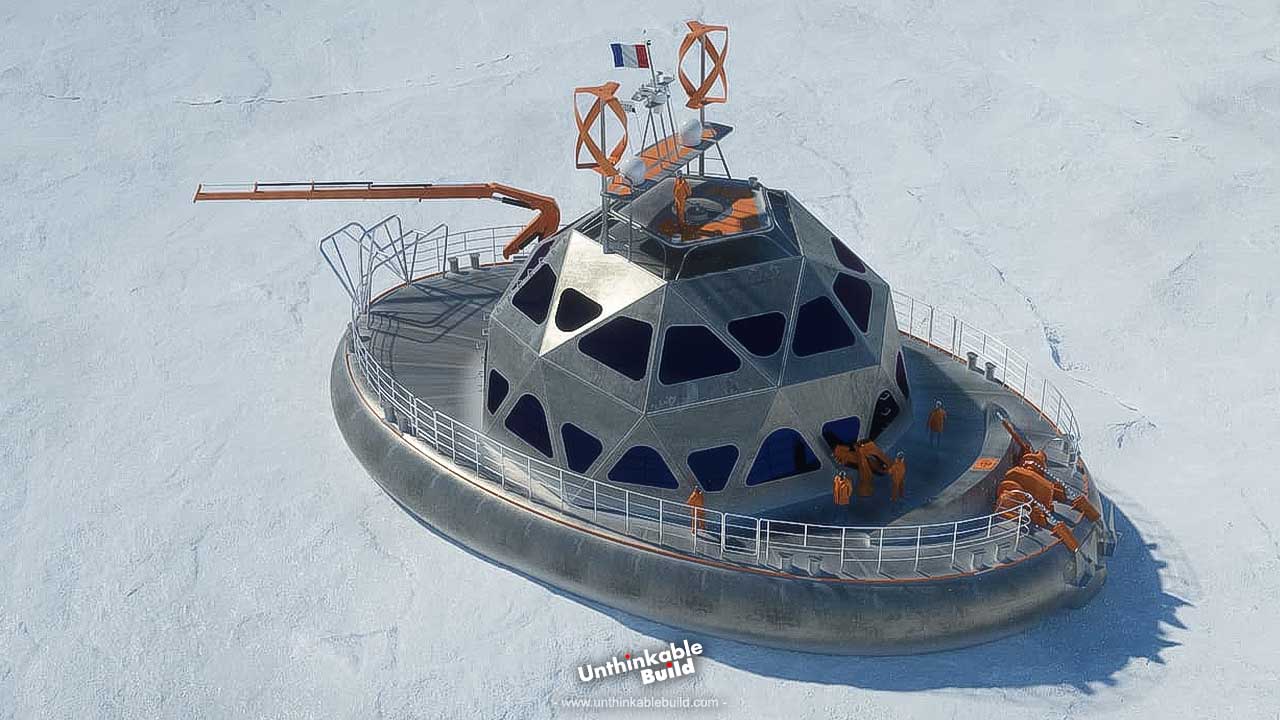France’s New Floating Arctic Research Project: Tara Polar Station
The Arctic Ocean is facing the harshest effects of rapid global warming, with its ice melting faster than ever before. This alarming trend is largely due to the release of greenhouse gases like carbon dioxide and methane, which come from burning fossil fuels, deforestation, and industrial processes.
To dig deeper into why the Arctic is being hit so hard, Tara Ocean Foundation of France has designed a state-of-the-art vessel, Tara Polar Station. This drifting scientific lab is a lifeline for understanding our planet’s changing climate, exploring the rich biodiversity of the Arctic region, and uncovering the true impact of global warming.
The Tara Polar Station is powered by a thoughtfully designed mix of carbon-free renewable energy sources like solar, wind and bio-sourced fuels, allowing it to stay operational for up to 500 days at a time. This impressive capability opens the door to an extraordinary, in-depth exploration of the Arctic, giving scientists the chance to study this unique environment like never before.
What makes the Tara Polar Station so special in its quest to uncover the deeper causes of global warming and the secrets of the Arctic? And how long will its journey last?
The ocean’s temperature has already risen by more than one degree Fahrenheit over the past 50 years, with its impact being most noticeable at the North Pole compared to other regions of the world. Although it might seem far away, the impact of these changes touches every corner of the globe. The Arctic is at the forefront of Climate change, as its icy surface reflects sunlight to help keep global temperatures in check. But as climate change continues to upset this delicate balance of nature, we’re facing more extreme and unpredictable weather patterns everywhere.
Also Read: Hawaii’s $12.4 Billion Transport Dream: What Went Wrong?
To better understand the forces driving these natural populations and to gauge what the future might hold, the Tara Oceans Foundation, France has taken on an exciting challenge to build a unique polar scientific station that looks like a space station from a sci-fi movie. It is an extraordinary drifting science lab, brought to life by French architect Olivier Petit. This cutting-edge project is dedicated to exploring the Arctic and will play a crucial role in monitoring climate change. In the harsh and remote environment of the Arctic Ocean, where global warming and pollution are having significant effects, Tara Polar Station seeks to uncover vital information for further scientific research.
Designed to brave the severe conditions of the Arctic, this cutting-edge vessel spans 26 meters in length and 16 meters in width, with a draught of 3.20 meters. It comfortably houses a crew of 18 people and has enough room for 130 cubic meters of Hydro-treated Vegetable Oil (HVO), ensuring it can sustain its mission in the challenging Arctic environment.
Life on board will be quite the adventure for its crew. Scientists from various fields, like climatologists, biologists, oceanographers, and more, will live and work in the extreme conditions of the Arctic, facing temperatures between -20°C and -52°C during the polar night. To ensure their comfort amidst extreme weather, the Tara Polar Station is equipped with heated cabins, a cozy mess room, and even a traditional steam bath.
While traditional Icebreakers are built to cut through ice, Tara Polar Station takes a different approach. The oval shape design of this vessel is ready to handle the huge pressure of moving ice and drift along it, becoming a natural part of the frozen landscape of Arctic.
Building the Tara Polar Station was no ordinary feat. The journey began with finding the right material to withstand the unforgiving Arctic environment. Aluminum emerged as the best choice due to its light weight, resistance to corrosion, and ability to stay flexible in freezing temperatures. But welding it posed challenges, and the hull needed thick, 20-millimeter sheets, which weren’t easy to come by.
The lower part of vessel, which would face constant contact with icy waters, was specially reinforced to endure impacts, while the upper part, made up of 6,000 individual pieces, had to be meticulously fitted and welded.
Once the hull was complete, attention turned to the superstructure, particularly the dome-like structure called geode was designed to house the living cabins and laboratories. While its construction was less complex than the hull, attaching it securely required careful planning and execution.
The laboratories of Tara Polar Station were designed to be modular, allowing scientists to reconfigure them based on the needs of each mission. To ensure everything fit perfectly and operated smoothly, the entire layout was modeled in 3D before its construction.
One of Tara Polar Station’s standout features is the moon pool, a large, open shaft that extends from the deck to the waterline. This essential feature allows scientists to lower their equipment into the ocean, even when the station is encased in ice, and reach depths of up to 2,500 meters. Simple in design, the moon pool plays a crucial role in enabling vital scientific research.
Finally, the collaborative effort of engineers, designers and workers in Cherbourg, France brought the Tara Polar Station to life. The result is a vessel that is incredibly resilient, ready to take on the Arctic’s challenges.
First expedition of Tara Polar Station is scheduled for 2026 and will embark on a 20-years journey of scientific exploration. The team onboard will collaborate with institutions from France, the United States, Canada, Switzerland, Germany, and Denmark. Tara Polar Station aims to understand how climate change is reshaping the Arctic and what it means for the rest of the world. It also strives to develop our understanding of Earth’s biodiversity by exploring Arctic regions that are otherwise unreachable. Tara Polar Station is set to carry out not less than ten missions in the Arctic region over the next two decades, running through to 2045.
This research will reveal how life adapts to extreme Arctic conditions, examine the consequences of pollution and melting sea ice on delicate ecosystems, and monitor changes in Arctic fish populations, including the effects of temperate species moving in.
Also Read: The Biggest Failed Megaprojects Around the World
As the Arctic’s ice melts, it uncovers darker ocean water, that absorbs more heat from the sun, rather than reflecting it away like ice does. This creates a vicious cycle; the more the ice melts, the more heat is absorbed, and the more the region warms. This phenomenon, known as Arctic amplification, also leads to permafrost thawing. When permafrost melts, it releases greenhouse gases like methane and carbon dioxide into the atmosphere.
The effects of these changes aren’t limited to the Arctic region, but they wave out to impact sea levels, weather patterns, global economies, trade, and national security. Rising sea levels, unpredictable weather, and extreme weather events are all connected to the shifts happening in the North Pole and especially Arctic Ocean.
The Tara Polar Station isn’t just about science, but a mission with a deeper purpose. It’s a reminder that such efforts are aimed at the planet’s well-being. Nature has an incredible capacity to bounce back when we give it a chance. By studying and addressing the impacts of global warming, we can find ways to help our environment heal and thrive again.







